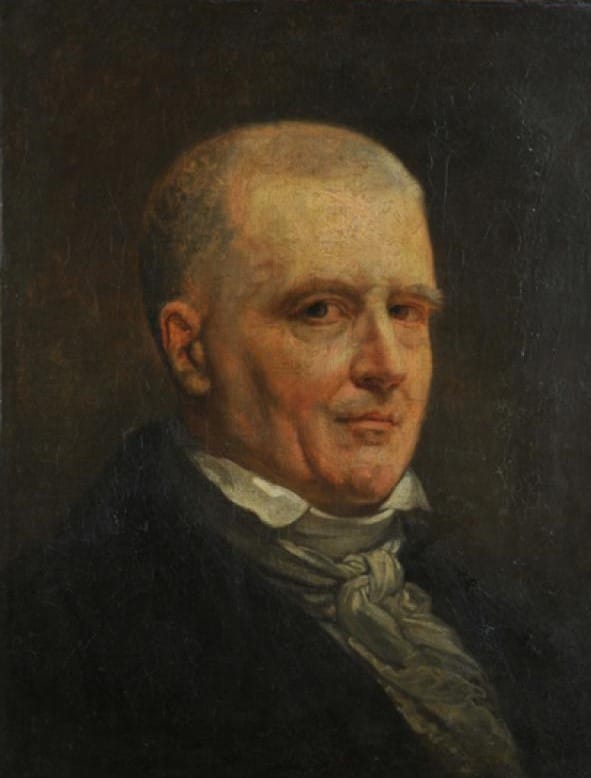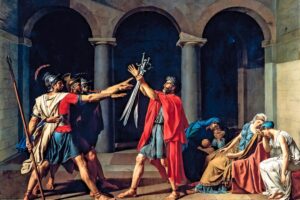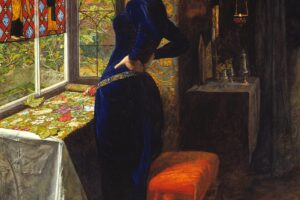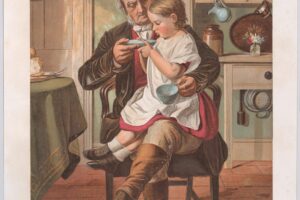A Rococo Love Story
Imagine a truly special moment, where love blossoms and someone’s devotion is celebrated with great joy! That’s the wonderful story told in “The Lover Crowned,” a magnificent painting by the French artist Jean Honoré Fragonard, created in 1772. This painting is part of a famous series called “The Progress of Love,” which tells a story of different stages of love, from first encounters to happy commitment. Fragonard, a master of the Rococo style, was brilliant at capturing feelings of romance, beauty, and playful elegance.
Triumph and Devotion
In “The Lover Crowned,” we see the joyful culmination of a love story, set in a grand and beautiful garden.
- The Honored Lover: On the left, seated on the ground with a look of pure happiness and adoration, is the young man, the “lover” of the title. He wears a striking red coat and breeches. His gaze is fixed entirely on the young woman, full of warmth and devotion.
- The Crowning Lady: Above him, the beautiful young woman, dressed in a shimmering cream and gold dress with a blue sash, extends her arm gracefully. She is about to place a garland of flowers – a crown – upon his head. This act of “crowning” him symbolizes her acceptance of his love and her acknowledgment of his devotion. She is adorned with flowers herself, showing her connection to nature and beauty.
- The Loyal Companion: Beside the young man, a loyal dog looks up at the scene, often a symbol of faithfulness in art, emphasizing the true love between the couple.
- The Attentive Friend/Musician: On the right, another young man is seated, perhaps a friend or a musician. He holds a book, possibly sheet music, or a writing slate. He looks on at the crowning moment, perhaps playing music or composing a song for the happy couple. His presence adds to the sense of a celebration.
A Garden of Romance and Splendor
The setting for this grand celebration is a truly magnificent garden, full of details that speak of luxury and nature’s beauty:
- A Grand Statue: High in the background, a large stone statue of cherubs (little winged angels, often symbolizing love) adds to the romantic and classical feel of the garden. This hints at the long-standing traditions of love and art.
- Lush, Overgrown Foliage: The garden is rich with vibrant green trees and climbing plants, some of which are wild and untamed, adding a sense of natural beauty and romance. The trees create a dramatic canopy overhead, with rays of light breaking through.
- Blooming Roses: On the right, a large bush of climbing roses, with their delicate pink and red blossoms, adds a burst of color and a strong symbol of love and beauty. Red flowers are also seen blooming in pots on the left, further decorating the scene.
- Scattered Treasures: On the ground around the central couple, you can see various items: an open book, scattered flowers, and perhaps a writing quill. These suggest leisure, learning, and the outpouring of poetic feelings often associated with love.
- Dramatic Sky: The sky is a mix of bright light and dramatic clouds, adding a sense of grandeur and excitement to the moment.
The Story of “The Progress of Love”
“The Lover Crowned” is a triumphant moment in Fragonard’s “Progress of Love” series. It celebrates the peak of affection, where a lover’s devotion is recognized and celebrated. It’s a joyful and heartfelt declaration of love, made public and cherished. Fragonard’s painting captures not just a scene, but an emotion – the joy, pride, and beauty of a love that has truly blossomed. It invites us to share in this special celebration, feeling the romance and splendor of a perfect moment in a magical garden.
About Artist

Jean-Honoré Fragonard (1732–1806) was a French painter and printmaker who is considered one of the leading figures of the Rococo art movement. His style is a vibrant and fluid expression of the late Rococo, known for its lightheartedness, sensuality, and free-flowing brushwork. Unlike his contemporary Boucher, whose work could sometimes feel more formal, Fragonard’s paintings have a spontaneous and energetic quality that perfectly captured the spirit of the French aristocracy on the eve of the revolution.
Artistic Style and Legacy
Fragonard was a student of François Boucher, and he inherited his master’s love for mythological and pastoral themes. However, Fragonard’s style is more dynamic and painterly, with a liveliness all his own. His work is characterized by:
- Energetic Brushwork: His brushstrokes are visible and expressive, creating a sense of movement and spontaneity.
- Lush, Luminous Color: He used a rich and glowing palette, with shimmering whites, rose, and gold.
- Playful Sensuality: He often depicted scenes of romantic trysts, playful games, and idyllic moments of love, with a light and often erotic touch.
Fragonard’s art fell out of fashion during the Neoclassical period, which favored more serious, moralizing subjects. He died in obscurity, but his reputation was revived in the 19th century, and he is now celebrated as a master of the Rococo.
Artwork Profile
All of the paintings you mentioned are indeed by Jean-Honoré Fragonard. They are excellent examples of his style and a testament to his genius.
- The Swing (c. 1767): This is arguably Fragonard’s most famous painting and a quintessential work of the Rococo period. It depicts a young woman on a swing, with her suitor hiding in the bushes below, catching a glimpse of her as she kicks off her shoe. The lush, overgrown garden, the playful sensuality, and the charming narrative make it an icon of the era.
- The Lover Crowned (c. 1771-1772): Part of a famous series known as “The Progress of Love,” this painting shows a young woman crowning her lover with a wreath of flowers. The scene is filled with a sense of joyous, unrestrained romance.
- The Musical Contest (c. 1754): An early work from his Italian period, it shows a group of young people engaged in a musical game, demonstrating his early interest in playful social scenes.
- The Shepherdess (c. 1760): A charming example of his pastoral scenes, it depicts an idealized country girl in a beautiful, natural setting.
- Blind Man’s Buff (c. 1750-1752): Fragonard painted a few versions of this popular game. The one in the National Gallery of Art is a lively, outdoor scene full of energy and flirtation.
- The Happy Lovers (c. 1765): A beautiful and tender portrayal of a young couple, it perfectly captures the idealized, amorous mood of his mature style.



